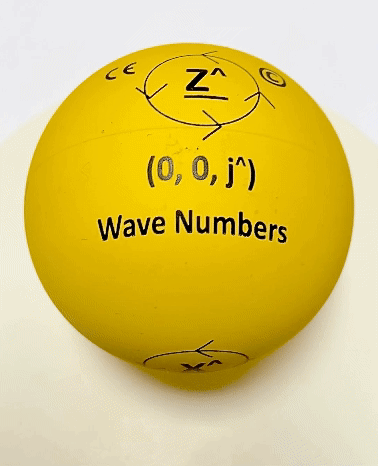Standard Orientation
To use the Wave Number Rotation Ball, hold it in a standard orientation before making any rotations. The standard orientation has X^ facing, Z^ to the north and Y^ to the east.
The fixed x, y and z-axes
The x, y and z-axes themselves do not move when rotating around them. It is the point in question that rotates. Hold the rotation ball by the z-axis with the Z^ at the north pole and rotate counterclockwise by a quarter turn in the direction of the arrows at Z^. As a result a point located at X^ rotates to Y^.
Rotating the prop rotates the x-axis. After the quarter turn rotation, the X^ has moved to the previous location of the Y^. It should be the point that has moved and not the X^. This needs to be taken into account when looking at rotations. To be clear, the axes are fixed and locations are fixed in relation to the axes. Rotation causes a point to move between locations.
In between rotations it is simplest to record the new location of a point and then return the ball to its standard configuration of X^ facing , Z^ to the north and Y^ to the east.
Example Rotation
Rotating a point located at X^.
- Holding the tennis ball by the z-axis with the Z^ at the north pole and X^ facing, make a one quarter or 90^o turn counterclockwise in the direction of the arrows at Z^.
X^ moves to the previous location of Y^. Interpret this as the point located at X^ moving to the location Y^. The point located at (^, 0, 0) had moved to the location (0, i^, 0).
- Return the ball to its standard configuration.
- Make a one quarter or 90^o turn counterclockwise in the direction of the arrows at Z^.
The Y^ moves to the original location of Xv. Again, interpret this as the point at Y^, (0, i^, 0), being moved to the location Xv at (v, 0, 0).
Two rotations of 90^o counterclockwise move a point from X^ to Xv. Another rotation of 90^o counterclockwise moves the point to Yv and a final rotation of 90^o counterclockwise, giving a cumulative rotation of 360^o, moves the point back to X^ where it started from.
Next: Euler and Tait_Bryan Angles
Previous: Wave Number Prop


